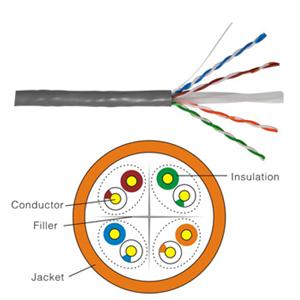Cat5 Vs. Cat6 Cables: Which is Better and Faster?
The other day, I was at a local computer shop to buy LAN cable and I asked for a Cat6 one. The guy simply opened a box and asked how long should he cut the cable.
At the same time, I began wondering how'd I distinguish between Cat5 and Cat6 cable just by visual inspection? I learn that Cat6 cables are thicker than then Cat5 cables; but if I've no reference cable - how do I go about identifying each one individually?
Update: Cat5 Vs. Cat6 : Differences
Here’s a quick guide to visually identifying Cat5 and Cat6 cables.
Visually identifying a Cat5 or Cat6 cable can be a bit tricky since they share a lot of similarities. However, there are some indicators that might help. Here's what to look for:
1. Labeling:
The easiest and most reliable way to determine if a cable is either Cat5 or Cat6 is by looking for printed markings along the cable sheath. Manufacturers usually print the cable category, along with other details such as the length, type, and manufacturing data, directly onto the cable sheath.
2. Cable thickness:
Generally, Cat6 cables are thicker than Cat5. This is because Cat6 cables have a structural difference - a longitudinal separator (also known as a spline) that isolates each of the four pairs of twisted wire within the cable. This helps reduce crosstalk and allows for higher data rates. Cat5 cables do not have this separator. However, not all Cat6 cables have a noticeable spline, so this isn't a fail-safe method.
3. Connector Design:
Sometimes, Cat6 cables use slightly different RJ45 connectors that accommodate the cable's thicker diameter. This is not always the case though, especially since Cat6 cables without a spline can use standard RJ45 connectors.
4. Cable Performance:
If all else fails and you have the necessary tools, you could test the cable's performance. Cat6 cables are designed to support much higher data rates than Cat5 cables. For instance, Cat5e (an enhanced version of Cat5) supports up to 1 Gbps at 100 meters, while Cat6 can support up to 10 Gbps under ideal conditions, but only up to 55 meters.
5. Performance Comparison
In terms of technical differences, Cat6 cables offer better performance than Cat5 cables due to improved crosstalk reduction and support for higher data rates.
This makes them a more suitable choice for networks that need to support high data throughput or that need to run over longer distances without loss of signal integrity.
However, for many home network applications, Cat5e (an improved version of Cat5 that also reduces crosstalk) may be more than sufficient.
If you're setting up a new network and plan on running cable, though, it may be worth investing in Cat6 for future-proofing, even if your current network devices don't support the higher data rates that Cat6 offers.
6. Backwards Compatibility
Both Cat5 and Cat6 cables are backwards compatible. They can be used in place of each other and even older Cat3 cables. They even have the same plugs. The end piece that both these cables share is called as RJ-45.
7. Can Cat6 cable improve Internet speed?
Cat6 cables offer more bandwidth; which means they can carry more data than Cat5 cables. Yes, Cat6 cables can improve your Internet speed.
Let me know if you have more questions about these cable types. I will be happy to answer your questions in detail.



